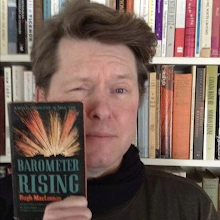Doors of the Night
Frank L. Packard
Toronto: Copp Clark, 1922
297 pages
The hero of this novel is a young man named Billy Kane. Raised a son of wealth – or so he thought – on the death of his father Billy learns that the family fortune has been long since spent. Happily, he secures a position as personal secretary to David Ellsworth, a known collector of rubies and one of Manhattan's richest men. Billy enjoys his work, but is concerned about his employer's generosity toward the less fortunate. It isn't that Billy doesn't believe in charity, rather that he's suspicious about those to whom Ellsworth gives money. Antonio Lavarto is a case in point:
The man was a pitiful looking object enough – one of those mendicants commonly designated in the vernacular as a "flopper." His legs were twisted under him in contorted angles at the knees, and his means of locomotion consisted in lifting himself up on the palms of his hands and swaying himself painfully along a foot or so at a time.Despite his best efforts, Billy hasn't been able to get anything on Laverto... that is, until the night Ellsworth asks him to deliver a gift of $2000 to the flopper's flat. Billy finds evidence that Laverto is indeed a fraud, but doesn't feel all that good about it; Ellsworth likes to think the best of people, and there's no pleasure to be found in proving the old man wrong.
Billy never has an opportunity to tell his employer about Lavarto. He returns from his errand to find Ellsworth has been murdered, the
ruby collection gone, and that he, Billy Kane, has been framed. Billy manages to elude the awaiting lawmen, but is shot in his escape. On the run, losing blood, he's mistaken for Bundy Morgan, alias the Rat, a kingpin of the criminal underworld. He regains his strength, then sets the Rat's gang off in search of the missing rubies. Billy's thinking is that in solving the Ellsworth murder and the mystery of the missing gems he will be able to clear his name. However, his plan is complicated by the appearance of a mysterious "Woman in Black," who seems to have something over the Rat. This means Billy must bend to her will.
What does she want?
She wants him to fight crime, of course.
Readers of Packard will find much of this familiar. Let's begin with Billy Kane, a name that bears some similarity to Jimmie Dale, alias the Gray Seal, the author's greatest hero. Like Billy, Jimmie was raised in comfort. Both take on the personas of disreputable men. Billy becomes a crimefighter because he's blackmailed by a mysterious woman, as is Jimmie. Even the flopper, a minor character, is familiar.
The first flopper I've ever encountered was in Packard's 1911 novel The Miracle Man. Like Lavarto, he's a fraud who only pretends to be "crippled." Played by Lon Cheney in the film adaptation, this earlier flopper is so great a character that he's mentioned on the cover of the Hodder & Stoughton paper edition:
H&S used the "Good it's a PACKARD [sic]" tag on several of its reissues. And why not? Packard was remarkably consistent. The bulk of his literary output has New York as a setting. It's a city with an underworld the Montrealer knew well, thanks in part to the NYPD, who allowed him to accompany them on raids. Manhattan is invariably divided into luxurious mansions of men like poor David Ellsworth and the squalor of rag shops, opium dens, dive bars, and cramped tenements in which members of the criminal class reign. In Doors of the Night they have names like Gypsy Joe, Red Vallon, Shaky Liz, the Cadger, and Whitey Jack.
"Good it's a PACKARD."
Doors of the Night is as good a place as any other to start reading Packard. This alone speaks to his talent.
Trivia: The most clever of all criminal schemes involves a character known as the Cherub, who spends two weeks pretending to be the grandson of a Shaky Liz. On the evening when the crime is to be committed, he has this to say:
I'd thought that diss originated with Wayne's World. Apparently not.
Trivia II: The quote on the cover of the the H&S paper edition of The Miracle Man doesn't appear in the novel, though something very similar is said by Helena to "gentleman crook and high- class, polished con-man" Doc Madison:
"Doc," she said, "it – it isn’t fair. It’s a shame – he can’t fight back."
Object and Access: A 297-page hardcover, mine is a copy of the first (and only) Canadian edition. It was purchased six years ago at London's Attic Books. Price: $10. Like Copp Clark's, the first American edition (Doran) and first British edition (Hodder & Stoughton) were also published in 1922. A cheap A.L. Burt edition followed. The last Doors of the Night saw print in the US was in 1931 as one of the Gray Seal editions (above) published by Doubleday Doran. The Hodder & Stoughton paper edition appears to date from about the same time.
Doors of the Night first appeared as a serial in The Popular Magazine (20 September - 7 December 1918).
The novel is held in one edition or another by Library and Archives Canada and twenty-two of our academic libraries.
Fifteen copies are listed for sale online, ranging from US$5.23 (a Fair A.L. Burt copy w/o jacket) to US$110.00 (a Very Good Doran 1st).
Related posts:













No comments:
Post a Comment